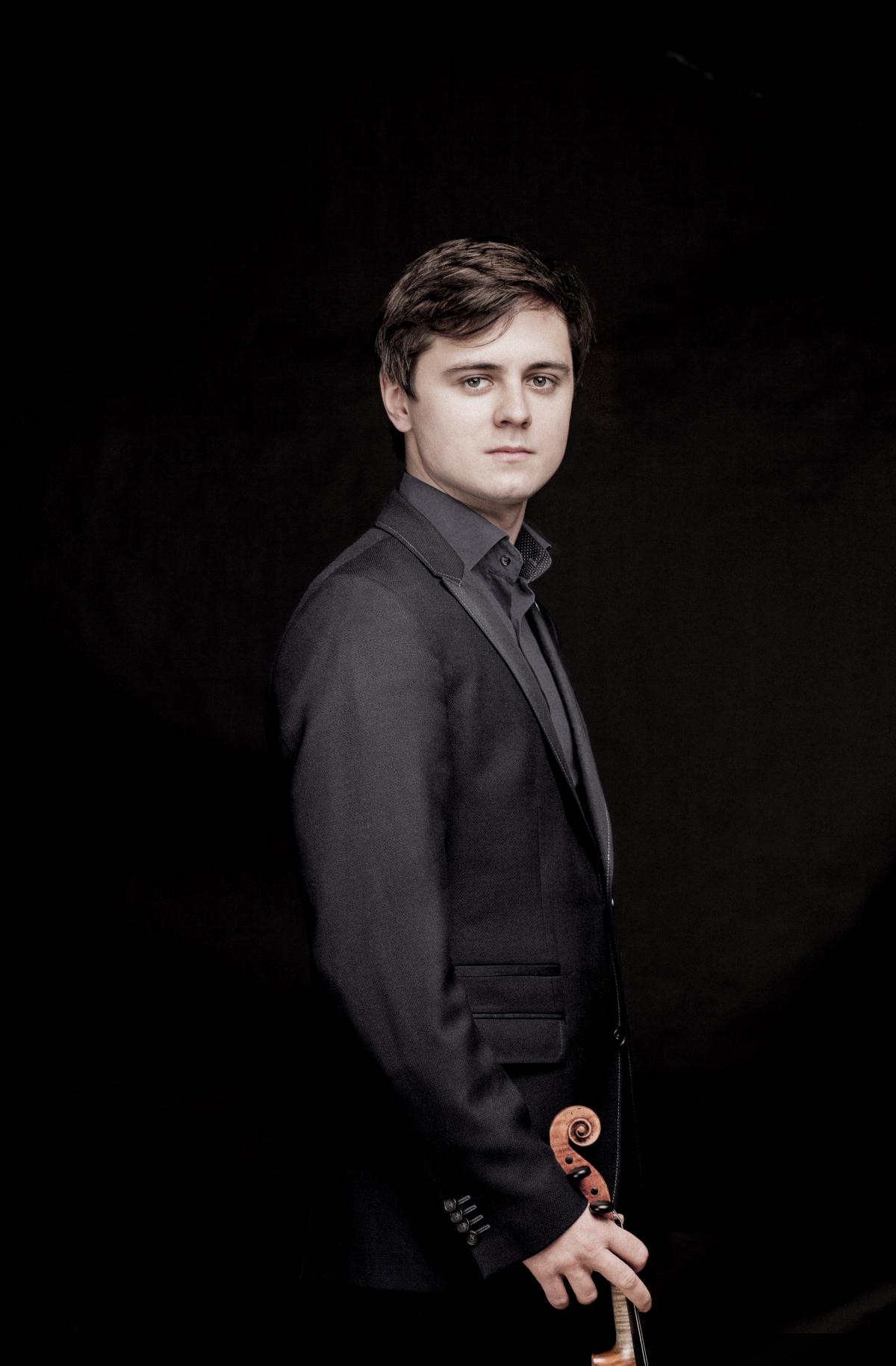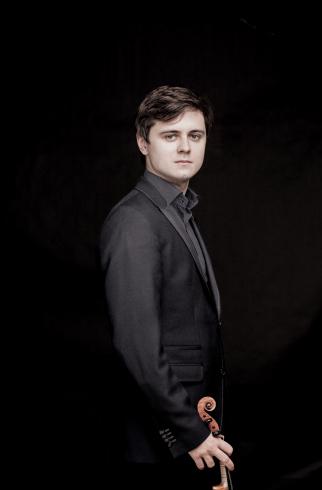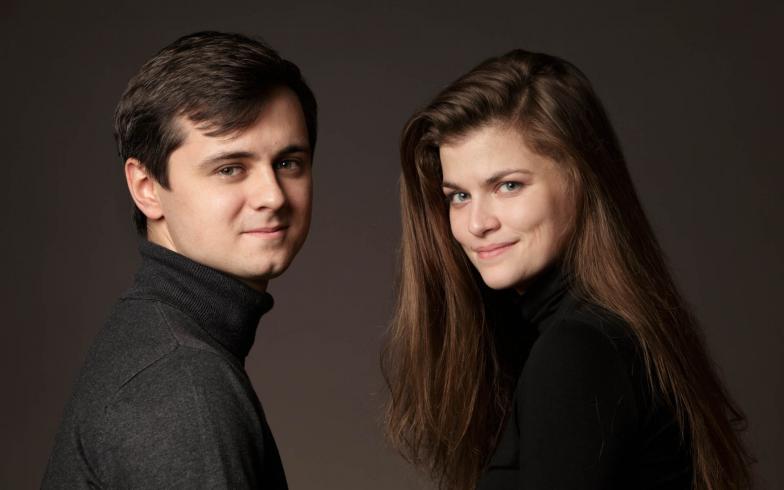Aleksey Semenenko & Inna Firsova
Violin and Piano

Aleksey Semenenko and Inna Firsova will make their Phillips debut with works by Mozart, Schubert, Ysaÿe, Debussy, and Henryk Wieniawski.
Program
Ukrainian violinist Aleksey Semenenko came to prominence in 2015 after his success at the Queen Elisabeth Competition in Belgium. He has performed in Russia, throughout Western Europe, and in the US where he was the New Artist of the Month in Musical America for March 2015. His regular recital partner is pianist Inna Firsova, who also has a successful solo career. As a duo, they were awarded “Best Concert” at the 2016 Dubrovnik Summer Festival. Their program includes Viennese classics by Mozart and Schubert alongside one of Ysaÿe’s solo violin sonatas, arrangements of music by Debussy, and Wieniawski’s dazzling fantasy on themes from Gounod’s Faust.
PROGRAM:
WOLFGANG AMADEUS MOZART (1770-1827)
Sonata No. 28 in E-flat Major, K. 380
Allegro
Andante con moto
Rondeau. Allegro
FRANZ SCHUBERT (1797-1828)
Fantasia for Violin and Piano in C Major, D. 934
Andante moderato
Allegretto
Andantino
Allegro vivace
INTERMISSION
EUGÈNE YSAŸE (1858-1931)
Sonata No. 5 in G Major “Pastorale,” Op. 27, No. 5
L’Aurore. Lento assai
Danse Rustique. Allegro giocoso
CLAUDE DEBUSSY (1862-1918)
La fille aux cheveux de lin (arr. Alexandre Roelens)
Clair de lune (arr. Alexandre Roelens)
HENRYK WIENIAWSKI (1835-1880)
Fantaisie brillante on themes from Gounod’s Faust, Op. 20
About the Artist
Ukrainian violinist Aleksey Semenenko is praised for his passionate performances replete with “stunning technique and intonation, verve, wit, delicatesse, and beautiful phrasing” (The Boston Musical Intelligencer), as well as consistently demonstrating “an unparalleled level of refined musicianship and stage presence” (The Strad). This was evidenced in his triumph at the 2015 Queen Elisabeth Competition in Belgium, where he captured Second Prize and went on to perform Laureate concerts throughout Belgium with the Orchestre Philharmonique Royal de Liège in Liege, Brussels, Namur, Charleroi, Hasselt, and Antwerp, and with the Brussels Philharmonic in Bruges and Ghent. In the 2015/2016 season he performed in Europe at the Musée du Louvre in Paris, the Rotary Club d’Arlon in Belgium, and the Rotary Gent-Zuid in Gent, and in the US, where he appears in recitals and concerto engagements at University of Florida Performing Arts, Tannery Pond Concerts, Merkin Concert Hall, the Embassy Series, the Eastern Connecticut Symphony, the DuPage Symphony, and the Meridian Symphony. He made his Alice Tully Hall concerto debut with the Orchestra of St. Luke’s on the Young Concert Artists Gala Concert.
Semenenko has appeared as soloist with orchestras including the Moscow Virtuosi, the Kiev National Orchestra, the Junge Philharmonie in Cologne, and the Sinfonietta Hungarica, among others. He appeared at the Interlaken Classics Festival in Switzerland as soloist with the Zakhar Bron Chamber Orchestra and toured Germany, performing recitals in the Best of NRW Series. At the 2011 Musik:Landschaft Westfalen Festival, he performed Paganini’s Concerto No. 2 with the National Philharmonic of Russia under Vladimir Spivakov, and was subsequently invited by the Spivakov Foundation to perform at the Kremlin in Moscow and at the Moscow International Performing Arts Center. Semenenko performed the violin solo from John William’s Schindler’s List with the Odessa Philharmonic Orchestra in Hamburg. An avid chamber musician, Semenenko founded the Stolyarsky Quartet, which has given concerts in Russia, the Ukraine, France, Malta, and Switzerland.
Semenenko’s other honors include First Prize in the 2015 Boris Goldstein International Violin Competition, Musical America’s New Artist of the Month (March 2015), the Audience Prize at the 2015 Musical Olympus International Festival in St. Petersburg, the Alois Kottmann Award at the 2010 International Day of Music Festival in Hofheim, Germany, and the Grand Prix of the 2006 National Violin Competition in Lviv, Ukraine.
Winner of the 2012 Young Concert Artists International Auditions, he was presented in debut recitals at Merkin Concert Hall and the Kennedy Center. At the Auditions, he was also awarded special prizes resulting in performances at the Paramount Theatre, the Usedomer Musikfestival, and the Friends of Music Concerts. He has also appeared in recital at the Isabella Stewart Gardner Museum, the Port Washington Library, Rockefeller University, the Vero Beach Museum of Art, the First Presbyterian Church of Myrtle Beach, La Grua Center for the Arts, and on the Embassy Series.
Born in Odessa, Semenenko began his violin studies at the age of six with Zoya Mertsalova at the Stolyarsky School, and only a year later performed Vivaldi’s Violin Concerto in A Minor with the Odessa Philharmonic Orchestra. He currently studies with Zakhar Bron at the Hochschule für Musik in Cologne. Semenenko plays a 1760-70 Carlo Ferdinando Landolfi violin, loaned to him by the Deutsche Stiftung Musikleben fund of Hamburg, Germany.
Born in Russia, Inna Firsova began studying the piano at the age of eight, with Svetlana Korzhova in Ukraine. After graduation from the Hamburg Conservatory of Music, where she studied with Grigory Gruzman, and later at the Musikgymnasium Schloss Belvedere, she joined the class of Arnulf von Arnim at the Folkwang University of the Arts in Germany.
Firsova won the second prize at the International Piano Competition Zolotyj Leleka in Ukraine as well as the first prizes of the International Piano Competitions Vivat Musica in Ukraine, and the Concerto Competition of the Folkwang University in Germany, as well as various prizes from the Lions Club in Germany.
The young pianist has been a recipient of a scholarship from the association Yehudi Menuhin/Live Music Now Rhein-Ruhr.
Currently Firsova collaborates as a permanent duo partner of the prominent young violinist Aleksey Semenenko. Together they have appeared at the Rhein-Ruhr Piano Festival, the Kharkov Philharmonie in Ukraine, the Beethoven House in Germany, the International Summer Academy in Cervo, Italy, among many other prestigious concert halls.
Notes
Wolfgang Amadeus Mozart, Violin Sonata in E-flat Major, K. 380
Composed in 1781, Mozart’s Violin Sonata in E-flat Major shows a marked advance on some of his earlier sonatas for violin and piano. In those works the violin is usually subservient to the keyboard, and often just provides elegant decoration to what is essentially a piano sonata. But by the 1780s, Mozart was writing duo sonatas that were conceived far more as dialogues between the two instruments. Mozart’s great biographer Hermann Abert wrote that the first movement was “powefully emotional and virtuosic,” while the slow movement is notable for being in G minor, a key Mozart often used for his most poignant and moving music (above all in works like the Symphony No. 40 and the String Quintet K. 516). The Rondo finale provides a contrast to the two earlier movements: it is the most lighthearted of the three, but also displays some sophisticated wit, not least with the delightful moment of hesitation before the last return of the main theme.
Franz Schubert, Fantasie in C Major Op. 159, D934
Schubert was inspired to compose his Fantasie for the Bohemian violinist Josef Slavík who worked in Vienna and was later described by Chopin as “a second Paganini.” It was composed in December 1827, just after Schubert had finished his song-cycle Winterreise. Slavík and Karl von Bocklet gave the first performance at a private concert in the Landhaussaal, Vienna, on January 20, 1828. Schubert’s music is here at its most expansive, and one critic at the premiere was notably unimpressed, writing that: “The Fantasie occupied rather too much of the time a Viennese is prepared to devote to pleasures of the mind. The hall emptied gradually, and the writer confesses that he too is unable to say anything about the conclusion of this piece.” This dismissive review, with the writer not even staying to the end of the work, indicates that Schubert’s more discursive later style was a problem for his audiences, and the Fantasie is a work in quite a loose structure, its sections all linked together. From the “Hungarian” mood of the start, suggesting the sound of a cimbalom, the opening violin theme emerges with hushed intensity, starting with a single note which blossoms into a wide-ranging melody. This leads without a break to the Allegretto, a charming movement in which the violin and piano seem to engage in a playful chase of each other. Schubert oscillates between sections in A minor and A Major, before embarking on a typically adventurous series of modulations that take the music into some extremely remote keys. This is followed by an Andantino, in A-flat Major—an extended set of variations on Schubert’s own song Sei mir gegrüsst! (D741) from 1822. A return of the music from the very start gives way to a robust and jaunty Allegro vivace. This is unexpectedly interrupted by a slower Allegretto where Schubert introduces another variation on Sei mir gegrüsst! as a late surprise, a reflective interlude before the final dash to the close.
Eugène Ysaÿe, Sonata No. 5 in G Major “Pastorale,” Op. 27, No. 5
Ysaÿe was one of the most enthusiastic advocates of the music of his time, and it was to him that both Franck and Debussy dedicated their Violin Sonatas. But he was also familiar with Bach’s Sonatas and Partitas and regularly performed the celebrated Chaconne from the Second Partita. In 1923, he attended a recital given by Joseph Szigeti that included Bach’s First Sonata. This was to prove an important creative catalyst: in conversation after the concert, Ysaÿe and Szigeti discussed the almost total absence of unaccompanied violin music composed in the two centuries between Bach and their own time (apart from dazzling virtuoso studies such as Paganini’s 24 Caprices). With Szigeti’s encouragement, Ysaÿe determined to do something about this, and quickly mapped out a plan for six Sonatas, with the intention of dedicating each of them to one of his younger colleagues, drawing on the individual qualities and characteristics of their playing (aptly enough, the first of them was dedicated to Szigeti).
The Fifth Sonata was dedicated to the Belgian violinist Mathieu Crickboom (1871–1947), one of Ysaÿe’s favorite pupils who played second violin in his string quartet. The musical language is poetic and impressionistic in the first movement (which depicts dawn, complete with sounds of waking insects and the rustling of the breeze), and earthy in the Danse Rustique finale. Ysaÿe’s Sonatas are an inspired 20-century response to Bach, and show him at his most inventive: “I allowed free improvisation to reign. Each Sonata constitutes a kind of little poème where I abandoned the violin to its fantasies. I wanted to associate musical interest with grand qualities of true virtuosity, a much neglected association since instrumentalists no longer venture into composition and are abandoning this task to those who do not know the resources and secrets of the medium.”
Claude Debussy, La fille aux cheveux de lin and Clair de lune
The two short pieces were both originally written for solo piano. The first of them, La fille aux cheveux de lin (The Girl with the flaxen hair) comes from the first book of Debussy’s Préludes and was composed in January 1910. The style of the music is disarmingly simple and unassuming, and Debussy borrowed the title from a poem of the same name by Leconte de Lisle. The image of the flaxen-haired girl in visual art has often symbolized purity and innocence, and that same spirit permeates Debussy’s exquisite miniature. In the same year as it was composed, Debussy’s publisher Durand had already issued two different arrangements for violin and piano (by Arthur Hartmann and Leon Roques), and others soon followed. Clair de lune (Moonlight), its title borrowed from Paul Verlaine’s poem of the same name, was originally written for Debussy’s Suite bergamasque in about 1890, but he made revisions before it was published in 1905. It immediately became one of Debussy’s most popular pieces and was issued in many different arrangements and orchestrations. The transcription for Violin and Piano by Alexandre Roelens (1881–1948) heard in today’s concert was first published in 1924.
Henryk Wieniawski, Fantaisie brillante on themes from Gounod’s Faust, Op. 20
The Fantaisie brilliante sur des motifs de Faust was composed in 1865, six years after the opera itself had first been staged in Paris, and a year after a successful production in St. Petersburg. Wieniawski was one of several virtuoso violinists to write showpieces based on Gounod’s Faust and similar compositions on themes from the opera followed in quick succession from Jean-Delphin Alard, Charles Dancla, Henri Vieuxtemps, and Pablo de Sarasate. After a brooding introduction, the soloist enters with a cadenza before continuing with Faust’s “Rien! En vain j’interroge” from Act I. This gives way to a more lyrical passage based on Valentin’s “O sainte médaille,” The third section introduces Mephistophèles’s “Le veau d’or” from Act II. The Act III duet between Faust and Marguerite (“Laisse-moi” … “Je veux t’aimer”) is used for a slower section before the brilliant finale, based on the famous Act II waltz (“Ainsi que la brise légère”). The Fantasie was first published in Leipzig by Kistner in May 1868 in both versions for orchestral and piano accompaniment. It was dedicated to King Christian IX of Denmark. Wieniawski wrote the work for himself to play, and the Illustrated London News reported on his visit to the Musical Union on May 22, 1866, where his performance of the Faust fantasy—its first in London—was “applauded to the echo by a crowded and fashionable audience.”
—Nigel Simeone, 2018

